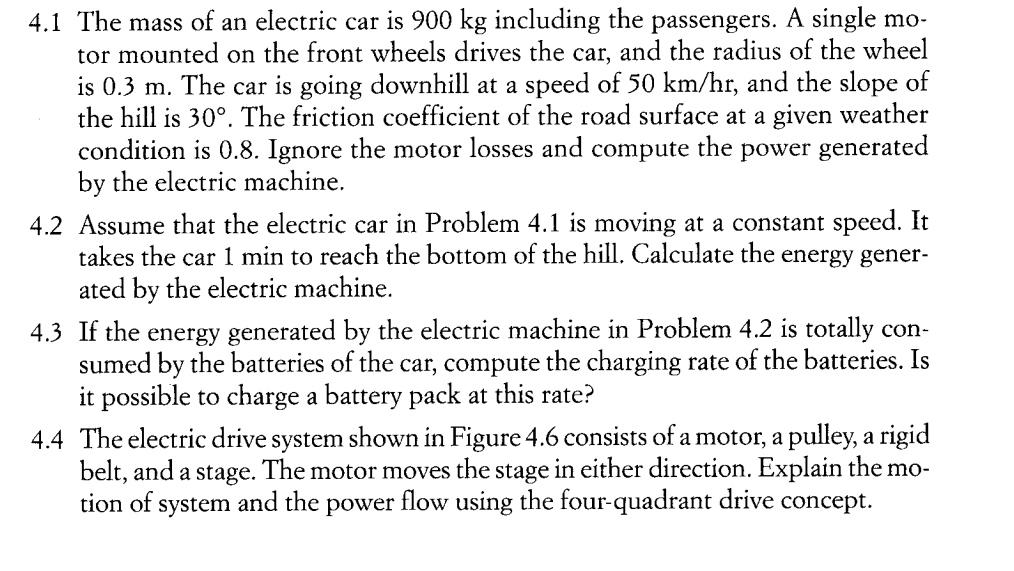4.1 The mass of an electric car is 900 kg including the passengers. A single mo- tor mounted on the front wheels drives the car, and the radius of the wheel is 0.3 m. The car is going downhill at a speed of 50 km/hr, and the slope of the hill is 30°. The friction coefficient of the road surface at a given weather condition is 0.8. Ignore the motor losses and compute the power generated by the electric machine.
4.1 The mass of an electric car is 900 kg including the passengers. A single mo- tor mounted on the front wheels drives the car, and the radius of the wheel is 0.3 m. The car is going downhill at a speed of 50 km/hr, and the slope of the hill is 30°. The friction coefficient of the road surface at a given weather condition is 0.8. Ignore the motor losses and compute the power generated by the electric machine.
University Physics Volume 1
18th Edition
ISBN:9781938168277
Author:William Moebs, Samuel J. Ling, Jeff Sanny
Publisher:William Moebs, Samuel J. Ling, Jeff Sanny
Chapter7: Work And Kinetic Energy
Section: Chapter Questions
Problem 76P: Calculate the power output needed for a 950-kg car to climb a 2.00 slope at a constant 30.0 m/s...
Related questions
Question

Transcribed Image Text:4.1 The mass of an electric car is 900 kg including the passengers. A single mo-
tor mounted on the front wheels drives the car, and the radius of the wheel
is 0.3 m. The car is going downhill at a speed of 50 km/hr, and the slope of
the hill is 30°. The friction coefficient of the road surface at a given weather
condition is 0.8. Ignore the motor losses and compute the power generated
by the electric machine.
4.2 Assume that the electric car in Problem 4.1 is moving at a constant speed. It
takes the car 1 min to reach the bottom of the hill. Calculate the energy gener-
ated by the electric machine.
4.3 If the energy generated by the electric machine in Problem 4.2 is totally con-
sumed by the batteries of the car, compute the charging rate of the batteries. Is
it possible to charge a battery pack at this rate?
4.4 The electric drive system shown in Figure 4.6 consists of a motor, a pulley, a rigid
belt, and a stage. The motor moves the stage in either direction. Explain the mo-
tion of system and the power flow using the four-quadrant drive concept.
Expert Solution
This question has been solved!
Explore an expertly crafted, step-by-step solution for a thorough understanding of key concepts.
This is a popular solution!
Trending now
This is a popular solution!
Step by step
Solved in 3 steps with 2 images

Knowledge Booster
Learn more about
Need a deep-dive on the concept behind this application? Look no further. Learn more about this topic, physics and related others by exploring similar questions and additional content below.Recommended textbooks for you

University Physics Volume 1
Physics
ISBN:
9781938168277
Author:
William Moebs, Samuel J. Ling, Jeff Sanny
Publisher:
OpenStax - Rice University

University Physics Volume 1
Physics
ISBN:
9781938168277
Author:
William Moebs, Samuel J. Ling, Jeff Sanny
Publisher:
OpenStax - Rice University